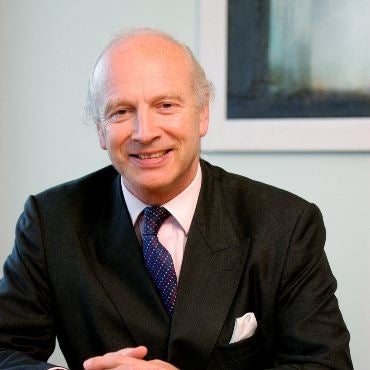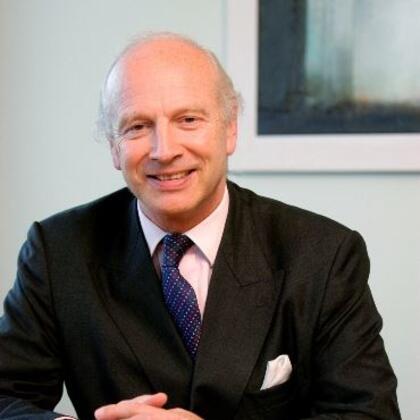What is the future of mutuals now?
Share
- Details
- Transcript
- Audio
- Downloads
- Extra Reading
Why did mutuals occur and what purposes did/do they serve? Some of Britain's greatest financial institutions have been mutuals, especially in the life insurance and building society spheres. In the past 15 years many of these have experienced problems which have caused them to wither, be absorbed or to get into serious financial/legal/reputational difficulties; many others have demutualised. A third group are successful, thriving enterprises, serving the needs of their members. What are the peculiar risks and opportunities associated with mutuality? Is size an issue? Does mutual status require a different company ethos and culture? What future do mutuals have?
This lecture features the following speakers: Daniel Hodson, former Gresham Professor of Commerce; Anthony Hilton, Financial Editor, London Evening Standard and Philip Williamson, Chief Executive, Nationwide Building Society.
Download Transcript
What is the future of mutuals now?
Professor Daniel Hodson
Mutuality pervades both our working and leisure lives, and this country is arguably the most notable exponent of the concept: building societies and golf clubs, professional bodies and cooperative retailers, the list is endless. My intention this evening is to concentrate on those in the business sector, setting out why they exist, what makes them successful (and/or fail), and then address some topical case studies as illustrations; and finally to draw some conclusions about where they are likely to go from here. Without any preconceived plans my own business career has spanned a wide variety of these institutions: for instance, the Association of Corporate Treasurers, and four of which you will hear more in this introduction, the London Clearing House, now LCH.Clearnet, DACS, the visual creators copyright cooperative, LIFFE, the derivative exchange and Nationwide Building Society.
It is an concept which affects our daily lives, and is not at all dull. Not for it the mordant attitude of the great Hollywood director, Sam Goldwyn. He was overseeing what should have been a singularly dramatic death scene, but getting increasingly frustrated. Finally he said : ‘the scene is just too damned dull. Tell him to put more life into his dying’
[Introduce guests: Philip Williamson, CEO of Nationwide BuildingSociety and Anthony Hilton, Financial Editor of the Evening Standard ]
Let me first state that in my view there is little tangible generic difference between a mutual and a cooperative, although their style may use one or other of these titles. I will use ‘mutual’ for tonight’s purposes.
I would suggest that a comprehensive description of a mutual is ‘a corporate organisation whose principle purpose is to serve the interests and common purpose of a specific group of beneficiaries, who may or may not be shareholders, by the provision of a defined range of services.’ They may seem therefore to be the products of self interest, but it is worth recording that many of our great building societies and mutual life insurance offices were started by people with enlightened, altruistic motives, on behalf of those weaker than themselves, to provide the latter with opportunities (savings mediums, housing, life insurance and annuities etc) not available elsewhere.
‘Not available elsewhere’ is of key importance with such institutions, for it is arguable that they would never have got off the ground if the relevant services had been satisfactorily provided to the beneficiary class. However there are of course today many competing products provided by non mutuals to those offered by our most successful and thriving mutuals. I would however argue that, to the extent that such products are available elsewhere in the market place, the case for mutuality is weakened, and the rationale for continued existence needs to be regularly reviewed by the institution. Is it for instance unviable in the long run, with the possibility of causing actual harm to its beneficiaries or others as a result of its demise? The problems of Equitable Life fall into this category, and we will focus on these later. Or would its beneficiaries be better off if it did not exist as a mutual, as some building society members and mutual insurance company policy holders have found from their ‘windfalls’ on demutualisation?
Passing this ‘ market ’ test is the first and one of the most important reasons why mutuals grown and been successful. I would argue that there are three other factors that have ensured their continued existence and economic importance to their beneficiaries and which provide tests which must be passed to ensure the continued success and prosperity of the institution:
Common purpose and vision: the beneficiaries of a mutual must share the same rationale for their being involved and require broadly the same products or services. Damaging conflicts will arise if there are splits in beneficiaries’ desires and needs, splits which may not have been envisaged when the institution was founded, and which may indeed result from the differing expectations of current and new/future beneficiaries, or from special interests groups within the broad definition of the beneficiary class.
Decisiveness: inability to make clear strategic decisions may be one harmful symptom of lack of common purpose, or it may be the result of a weak governance structure. The latter should empower the Board (I will use this as a generic term for the sovereign decision making body) to make the tough and farsighted decisions necessary for a strong future and the continued usefulness of the institution to its beneficiaries.
I wouldn’t however go as far as the board pundit of whom I heard recently who said that you should always have odd numbers on a board, and three was too many.
Accountability: the quid pro quo of empowerment is accountability. The governance structure must ensure that both Board and senior management are clearly answerable to beneficiaries, the main stakeholders, who must have the ultimate power to remove them if they malfunction; that power should be tangible and available through clear mechanisms and not just theoretical.
Transparency: the institution must be transparent to its beneficiaries as to its strategy and objectives, its key policies and its decisions, and its commercial and financial performance both now and in the future. Only if appropriate levels of transparency are available can accountability be properly exercised.
To aficionados of plcs, with their clear shareholder orientation and voting rights and governance in accordance now with the Combined code, much of these last four tests can seem unexceptionable. But the structure and governance of mutuals often varies significantly from this familiar norm.
We can only learn about the future from the past, and I now intend to use some case studies, telling tales of success and failure, to illustrate these tests and to draw some conclusions about future prosperity.
First let us consider the story of LCH Clearnet (the merger of the London Clearing House with Clearnet, following the takeover of LIFFE by Euronext). After a decade of turbulence continues, at least so as voting rights are concerned – Euronext owns 45% but can only vote for 24.9% - to be majority owned by its main users, the clearing members of exchanges where trades between participants can be cleared – or guaranteed. The constitution and governance determined ten years ago was only achieved after prolonged wrangling and examination of various models, including (as in other places, notably Frankfurt) ownership by one or more exchanges. The determining factor was the shared knowledge that clearing was of such overriding importance (and profitability) to the those trading at a wholesale level on exchanges, otherwise known as exchange members, that they wanted to control and order it to the point of ownership; however as a key concession to their importance to the LCH, a minority stake was allowed for those exchanges.
The governance framework was crafted to ensure that the latter three tests were, as far as possible, satisfied: the board was small but representative, the constitution democratic, and the relationship with the members extremely close given that they were using the institution every minute of every trading day.
But the continued existence of the exchange ownership, now, for voting purposes close to 30% rather than less than 20% in the premerger days, creates tensions which could yet prove a serious setback for LCH’s particular hybrid form of mutuality. There is still a common vision for clearing members, but could it in the long run differ from that of the exchange shareholders, and how would that conflict be resolved? There is a measurable probability that such a situation many occur.
This may be exacerbated by the fact that the ‘market’ test is not satisfied by LCH, since it was and remains the fact that clearing is available at other institutions, and indeed a clear indication of that was recently provided by the row over whether the London Stock Exchange (LSE) should continue to clear at LCH or should go to the Deutsche Borse (DB) clearing house in Frankfurt. But the resolution of that issue is instructive. Pressure from members, at least partly driven by the desire to keep clearing under their strategic and operational control, resulted in LSE’s deciding to stay at LCH. In effect the members valued their shared purpose and influence far more than what was on offer from Frankfurt – at that time.
I say ‘at that time’, because there is an interesting play in exchange competition currently. European competition authorities are concerned about DB’s control of its clearing house and its requirement for trades undertaken on the Exchange to be cleared there rather than where the participant wants to clear. There is a plausible argument that says that a common European clearing house at which all trades done on European exchanges would be cleared would ironically increase beneficial competition between exchanges; in effect users would decide which on exchange (and particularly LSE and DB) to trade based on liquidity and price, and not on clearing. So it may just be that the shared purpose of members of LCH will be sufficiently powerful to eliminate its main market competitors and move it from its current position of failing the ‘market’ test to being in effect the single European supplier of clearing services. And until that happens, and whilst clearing is available from other sources, LCH should theoretically at least review its continued existence as a mutual from time to time; its market certainly will. Nonetheless the LCH remains an example of a highly successful thriving and growing mutual, albeit a hybrid one, and with some potential future instabilities associated with its exchange shareholding and competition from elsewhere.
Another mutual in an entirely different field, but one which, like LCH, has recently reinvented itself, is the Design and Artists Copyright Society (DACS), which exists in its own words to ‘promote and protect the copyright of visual creators’. It was born twenty years ago to represent the interests of well known foreign fine artists but also, in the classic tradition of mutuals, to protect the weak and underrepresented, in this case British visual creators in copyright who were in danger of being exploited by those who sought to reproduce the images which belonged to them.
But the constitution which emerged had significant flaws which had begun in recent years to erode DACS effectiveness: the principal one being the competing requirements of two classes of membership, one based on ‘primary’ rights (where a specific and identifiable image was to be licensed) and one based on ‘secondary’ or ‘collective’ rights (where it was difficult to identify a specific use of copyright, but it was clear that it had occurred, as in TV broadcasting, and the academic use of photocopied images). Worse, it seemed to some as if the latter class were cross subsidising the former.
There were other issues of clarification, such as the extent of representation (was DACS really only for fine artists?), and the Board structure was unwieldy. Furthermore, and perhaps most importantly, members showed absolutely no interest in their rights of accountability, a handful turning up at AGMs and for the most part looking confused and uncomfortable at the arcane proceedings. In a nutshell, the institution was beginning to lack a common purpose and it was in effect neither transparent not accountable, given the total lack of interest in such matters by its beneficiaries; the tests for successful mutuality were not passed.
And there was beginning to be competition, in that dealers and image libraries were starting to offer a basic copyright service.
So the Board made it a top priority to overhaul the constitution and modus operandi. The distinction between individual members was eliminated (allowing for other collective institutions to have a form of membership), the wide range of potential membership emphasised and the Board streamlined, within guidelines for a balanced and effective group of directors.
Two problems remained. The principal one was how to make the institution accountable and transparent, given the average member’s total disinterest in such matters. This was solved in a novel way with two interlocking mechanisms: first to devise a clear but fairly full Members Charter setting out aims and standards, including specifically in respect of transparency and consultation. And second to set up a Creators’ Council, parallel to the Board and consisting mainly of visual creators, to provide strategic vision and purpose and with an absolute right of recommendation and consultation, but only to be binding on the Board in respect of changes to the Members Charter, which it would have to approve. The Board would otherwise remain sovereign, although there would be provision for the removal of directors by the membership.
This imaginative and flexible approach kept visual creators at the heart of the Society, and reinforced the tests other than the ‘market’ test; without such changes there was a serious possibility of dissension and decline. For the ‘collective’ aspect of DACS affairs the market test does not apply for it is the single and only institution to which collective licence fees are paid by institutions like the BBC and Universities UK for distribution according to a sophisticated methodology to a vast range of creators (many of whom are actually not members).
For primary licensing the position is different. The service provided by DACS is arguably broader and more comprehensive than provided by others, and for the most part half the price, but it is, nonetheless, available in the market place. It is an issue on which the new board will undoubtedly have to keep an eye, particularly if such services become more broadly available.
From the tales of two modern mutuals which have reacted to changing times and have continued highly relevant and successful, to a well publicised story of failure, that of Equitable Life. Briefly, for the history is in reality highly complex, Equitable is a mutual organisation which for many years, as part of its range of services, sold a highly successful life insurance product for pension purposes: it had a guaranteed annuity rate which meant that on maturity of the policy it could be exchanged for a guaranteed stream of income. Annuity rates move in line with prevailing interest rates and when the latter started to decline the guaranteed annuities of Equitable became very attractive to policy holders, but increasingly expensive and burdensome to the mutual’s life fund from whence they would have to be paid. At the same time Equitable was following the industry habit of declaring unguaranteed terminal bonuses for maturing policies as a means of selling policies and keeping money flowing into the its life fund, promises which, with the guaranteed annuities making an increasing financial hole, the life fund and the company would, it became more and more clear, be unable to keep. The result of these irreconcilable demands led to the need for Equitable to break its word to a great many of its policy holders, and particularly to those with guaranteed annuities; and the mess, recrimination, litigation and individual misery for those who depended on a company with such a fine record are all now history.
I will not dwell on the alleged inadequacies of management and successive boards, but will focus on the key question as to whether Equitable failed at least in part because it was a mutual. I fear that the answer must be ‘yes’, since the key tests were manifestly not passed:
Common purpose and vision: by the time the game was up, the Society, despite having only one life fund, was selling traditional life products with widely differing guarantees, pensions and pure investment product. In addition the potted history just stated readily shows the conflict between existing and future policy holders.
Decisiveness: the Board, which should have been decisive, had much experience, but was not actuarially literate and had no independent actuarial advice. Key decisions were taken at management level, the latter mixing their wide discretion with ‘impenetrable complexity’. In the circumstances it was impossible for the Board to be decisive, because in a nutshell it did not know much of what was going on.
Accountability: the Board was the archetypal self perpetuating oligarchy, and policyholders, the mutual beneficiaries, had no effective method of removing it or individual members, or calling it to account. And, for its own part, it was also manifestly not able to hold management to account either.
Transparency: the problems of reliable and appropriate information being received either by actual/would be policy holders or by the Board should be readily apparent. One example quoted in the Penrose report illustrates: ‘the executive management resolved as early as 1983 on the approach to meeting the cost of annuity guarantees from terminal bonus….This decision was not communicated to the Board until 1993, and not to policyholders in any form until 1995’.
But could Equitable Life have passed the tests as a mutual? Certainly the accountability and transparency tests could have been met by appropriate governance. Changes would have been involved to be sure, and might have been difficult to secure but they were certainly feasible.
The common purpose and decisiveness tests are much harder to pass. As I have pointed out, the rights and expectations of different types of policyholder clearly created conflicts of interest, and decisions which inevitably involved advantaging one type of mutual beneficiary at the expense of another. In addition the market test is also problematic, since there were and are proprietary insurance companies offering broadly the same products, making decisions based on shareholder interest, which might but would not necessarily always equate with a particular type of policyholders interest.
I shall however duck the consignment of the mutual insurance movement to the scrap heap, and leave it for further discussion by my guests. It would be particularly interesting to hear Philip’s views on beneficiary conflict resolution in mutuals with wide product ranges, the interests of beneficiaries for instance differing according to whether they are past, present or future
I shall however quickly point out the impact of lack of decisiveness on a mutual with which I was quite intimately connected, LIFFE. In several lectures during my time as Gresham Professor of Commerce I have described the problems that mutuality and the resultant governance structure created at LIFFE when it was faced with the critical decision of whether or not to embrace electronic trading. In short its constitution let it down at a critical moment, and in the face of competition from a well managed and determined proprietary competitor, which was well able to make tough decisions, even if they disadvantaged some of its customer/members or other stakeholders. LIFFE learned this lesson the hard way, losing a key product – and promptly and successfully demutualised.
The irony however is that one is now beginning to hear calls for remutualisation, particularly in respect of the London Stock Exchange. This seems to be centred around the fact that exchanges with their ability to facilitate large block trades with transparent price and volume are seen as competition to those investment houses who would much rather do such transactions off exchange and opaquely as to price (and therefore their earned margin) and amount. This attitude has recently expressed itself in the argument about minimum margins at LSE – some members complaining that they are too thin for profit.
So some people would like to put the genie back in the bottle in order to better their own interests. But even if the genie were amenable, and most aren’t once released, would, for instance, LSE survive as a mutual? The problems of decision making based on a potentially divided membership, in the face of strong and wilful competition would probably reappear. However the idea of remutualisation is an interesting one, and I will again leave it on the table for my guests.
So what do we learn from these case histories about the future of mutuals?
Here are some thoughts for discussion by my guests, in the case of Philip of course illustrated by his own vision and experience as CEO of a very successful example:
Mutuality can and does thrive in circumstances where the institution keeps to the basic formula of a common purpose, defined products and a specific group of beneficiaries It does require constant attention however and the need, from time to time, to make changes reflecting changing circumstances, as DACS and LCH have done. What changes does Nationwide see necessary to sustain its future, or is it steady as she goes? In particular it becomes more difficult to sustain where the defined products are available from proprietary sources elsewhere and the potential weaknesses in mutuality, such as lack of decisiveness, undermine its ability to compete, as LIFFE found when confronted with the need to make a decision on electronic trading. Nationwide competes in a heavily populated market place. How does it see itself maintaining an ongoing Unique Selling Proposition (USP), as against demutualisation and the provision to at least some of its members of a capital benefit which may be more valuable to them as cash in hand than a vaguer promise of future gains. These problems arise in particular when the product offering is wide ranging and complex and conflicts arise between different types of beneficiary, as both LIFFE and Equitable Life found. Does Nationwide face the same problems, and how does it resolve them? Other potential weaknesses centre round governance: decisiveness, accountability and transparency. If these are not addressed in the constitution the results may be disastrous, as was found in the case of Equitable Life. For the most part however they are rectifiable within the framework of a mutual. But they need regular review.
In setting the scene I am conscious that I have not had time to address several important issues, but maybe my guests can supply the answers. For instance, Equitable Life is often seen in part as a failure of regulation. If so, was the regulatory failure supported by Equitable’s mutual status and does this mean that mutuals need some special regulatory attention, in some way different from that afforded to regulated proprietary institutions?
And finally I well remember a member of the audience at my last lecture on this subject here cornering me and saying that the reason why he supported mutuality was the philosophy behind it, the idea – in part a political or even a theological one perhaps – that it represented people working together for each other for their common benefit; and a way of avoiding putting money into the pockets of the shareholders of a proprietary company. Is this, taken by itself, a sufficient reason for mutuality? What do my guests and members of the audience think of that?
Enough questions. Time for answers.
WCFields said: ‘Start every day off with a smile and get it over with’. Now you’re over with me, I leave the stage to my guests
Daniel Hodson
23 November 2004
This event was on Tue, 23 Nov 2004
Support Gresham
Gresham College has offered an outstanding education to the public free of charge for over 400 years. Today, Gresham plays an important role in fostering a love of learning and a greater understanding of ourselves and the world around us. Your donation will help to widen our reach and to broaden our audience, allowing more people to benefit from a high-quality education from some of the brightest minds.


 Login
Login






